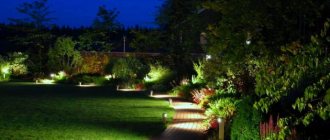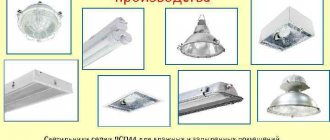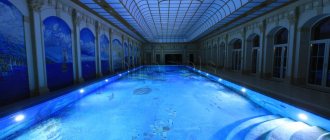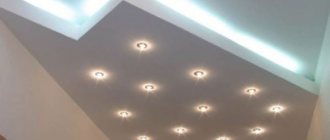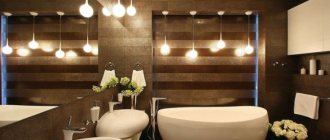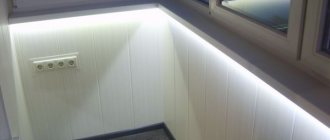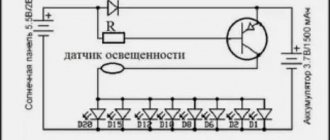Basic requirements for site lighting
The organization of the lighting system should be carried out taking into account various factors, so that at night the summer cottage is not only safe, but also does not lose its aesthetics. The following requirements are put forward for lighting of dachas and courtyard areas of country houses:
- safe electrical wiring, the presence of an RCD and a circuit breaker in the circuit;
- convenient lighting control;
- all system components, incl. lanterns, light bulbs, switches must be intended for outdoor use, be moisture and dustproof. Cable laying is required in a corrugation or pipe;
- All areas of the dacha need to be illuminated; ideally, in the evening and at night the boundaries are perfectly visible;
- use of energy-saving light bulbs. This point is especially important if outdoor lighting is required daily.
In addition, you will need to develop a lighting scheme for the area. This must be done according to a certain rule.
Attention!
It should be drawn up before the start of landscape design work. Otherwise, when laying cables, you will have to destroy existing elements.
Varieties
Landscape lighting is an important aspect that can make a yard or garden visible and even mysterious after sunset. This is necessary so as not to accidentally spoil the flower garden or beds in the dark.
It is only necessary to approach the organization of light distribution scrupulously.
Drawing up a lighting plan for the area
Due to the large assortment, making a choice is quite difficult. I want to use everything at my summer cottage:
- decorative type lanterns;
- illuminated garden figures;
- lamps with moonlight;
- colored lanterns designed to decorate tree crowns;
- garlands, etc.
All this can cause chaos, which can be avoided if you think in advance about the main locations of the lamps, their number, dimensions, determine the functionality of the lighting and choose the style of lighting fixtures.
To do this, you need to draw up a plan diagram of the location of all the lamps on the site. For this purpose, you can use a photocopy of the territory diagram or draw a scale plan indicating all existing buildings.
Attention!
It is necessary to create a lighting plan in parallel with thinking through the remaining elements of landscape design.
The locations of future lamps are determined along with the design of gazebos, garden paths, ponds, patios, terraces and other recreation areas. If you don't do this, there is a good chance that you will have to redo some of these elements due to the need to run power cables.
You will need to draw up an electrical connection diagram: anyone who has at least a little knowledge of electrics can handle this task. But the entire lighting system must be installed by a professional so that it is safe for summer residents.
Scheme of external lighting of a summer cottage
As you understand, examples of site lighting depend on the area of the site, its shape, your need for lighting, types of lighting, control scheme and many other parameters.
Moreover, many of them are quite subjective and even the most approximate scheme will be only partially correct. Therefore, we will consider only the basic rules for forming an external lighting network.
So:
- First of all, this is the distribution panel. PUE standards recommend sharing loads. Therefore, the ideal option for household needs and outdoor lighting would be to organize your own distribution panel, which will be connected directly from the meter.
- The number of groups in an external lighting network is calculated in the same way as for an apartment or house, so we will not focus on this issue. Fortunately, there are more than one instructions on this topic on our website.
- If your control circuit involves the installation of timers, light sensors, starters and other similar equipment, then it is better to place it inside the distribution cabinet.
Note! When we talk about light sensors, we mean devices with a remote sensor and a stationary actuator. They are now quite widely represented on the market.
Light relay with remote element
- In addition to group circuit breakers, we recommend installing an RCD circuit breaker on each group of outdoor lighting. The PUE standards do not require this, but for safety reasons it certainly won’t be superfluous. This is especially true for lines in which, in addition to the lighting network, it is planned to install sockets.
Now regarding the wiring. It can be done underground or overhead, as shown in the video.
So:
- If you plan to install the supply wiring underground, then according to clause 2.1.78 of the PUE, this cannot be done in steel pipes and ducts. To protect against mechanical damage in this case, we use plastic pipes or corrugation (see How to choose metal corrugation for wiring).
- If you plan to install overhead line wiring, then the height of the wire at the bottom of its sag according to clause 2.1.76 of the PUE should not be less than 3.5 meters. And above the road it’s even 6 meters.
- When laying wires along the facades of buildings, you should adhere to the standards of clause 2.1.75 of the PUE, shown in the photo. In this case, in all cases, laying wires on the roof of the building is prohibited.
- Distribution boxes, switching devices and lamps must have a protection class corresponding to outdoor installation. Usually this is IP44 and higher.
Types of site lighting
The lighting of a suburban area is assigned several functions simultaneously, for each of which a separate type of lamp should be provided.
Functional
The tasks of functional lighting are simple and clear. If decorative lighting cannot be used in every summer cottage, then it is impossible to do without general lighting. When highlighting all the important elements to increase the safety of movement around the territory, it is worth remembering that the accents in lighting should be placed on gazebos, patios, houses and other buildings.
Attention!
Garden paths should not be flooded with too much light so that those walking along them experience discomfort.
The most illuminated place on the site is the facade of the house and the porch: it will be more comfortable to move from less illuminated areas to brighter ones. Even late at night, functional lighting should allow you to see the boundaries of the site.
It is also necessary to highlight stairs, curbs, bridges and other most dangerous objects. Lamps should be placed evenly along the paths. The light source can be lanterns, floor lamps with frosted glass diffusers, bright spotlights, spherical lamps and other elements.
Decorative
This type of lighting is needed for recreation areas and objects that you want to admire even in the dark. Often, additional lighting is installed on flower beds, trees, shrubs, fountains, ponds, alpine slides, garden sculptures, as well as gazebos, patios and benches. Decorative lighting complements the main lighting and provides dim light, creating a romantic and slightly mysterious atmosphere. There are many ways to organize it - it all depends on the style of the site and the imagination of the owner.
To choose the right style of lamps for your garden, you can use a simple rule. The more elaborate and diverse the landscape design of the garden, the simpler and more concise the lighting items should be. If the style of the site is close to minimalism, then you can use lamps of the most bizarre and non-standard shapes, placing the emphasis on them in decorating the garden.
Marking lighting
Marking type of lighting is a tandem of decorative and functional light. The main task here is safety of movement.
To do this, you need to mark the following objects:
- Stair steps (garden, residential). Choose models that are intended for street use. They can be either seasonal or year-round. They are made from high-strength raw materials and are designed to last for many years.
- Children's playground along the contour, along the border of the recreation area, paths. This requires universal devices. Lamps must be resistant to temperature changes, rain, snow, hail, and not afraid of dust.
The main types of lamps for the garden
It is desirable that the illumination of the area be a stylish and functional addition to it, and also not become a source of high electricity costs. Traditional incandescent lamps cannot be called the most economical option, because... During operation, they become very hot, which consumes most of the energy, quickly burn out, and at low temperatures can even explode. You can replace incandescent lamps:
- luminescent and halogen devices, characterized by economy and long service life;
- LED lamps and strips do not heat up, consume minimal energy, shine quite brightly, and in terms of durability they confidently outperform competitors. In addition, when using this type of lamps, you can easily change the brightness of the lighting. Often, decorative lighting is created using LEDs, arranging hidden lighting for ponds, steps, benches, the facade of a house, or hiding them in the crown of trees or shrubs;
- fiber optic systems are a new word in the field of garden lighting. Can be used as sources of main or additional light, architectural lighting or decoration of pools and ponds. Such a system consists of a projector (light source for the optical fiber), an optical cable or fiber, a common input, threaded attachments and various terminal devices. It turns out that with just one generator it is possible to provide lighting to a large area. The main advantages of the system: ease of operation, long service life, cost-effectiveness and the absence of requirements for waterproofing of lamps.
Separately, it is worth highlighting such non-standard modern solutions for garden lighting, such as paving slabs with LEDs built into them and fluorescent tiles with the ability to accumulate solar energy during the daytime.
Rules for creating garden illumination design
Creating a lighting complex for a country house begins with planning on paper. It is necessary to prepare a detailed plan of the site and mark on it all buildings, gazebos, paths, flower beds and other significant objects that need lighting.
According to this plan, identify the following key points :
- total number of lamps;
- their location and what function they will perform (decorative or practical);
- which of the lanterns will be powered from the mains, and which ones will be powered by solar or simple batteries;
- what models of lamps will ideally fit into the design of the site.
It is useful to take pictures of the area from different angles and at different times of the day. This will help you understand which objects need to be highlighted and which ones should be left in shadow.
As a rule, the central areas of the site are highlighted with bright light: the entrance to the house and the garage, the main paths, the gazebo. Soft lighting is required for secondary paths leading into the depths of the garden or to a resting place or pond. Flower beds, garden sculptures and other landscape objects are unobtrusively illuminated.
When creating a lighting scheme, you need to remember safety and be sure to highlight the following objects :
- swimming pools and other bodies of water;
- steps and retaining walls;
- low hedges.
Next, with the help of specialists, a scheme for laying electrical networks, underground or overhead lines is outlined. It should be remembered here that the shorter the length of the electrical cable, the smaller the cross-section you can choose and the cheaper the installation will be. For lighting devices located far from home, it is better to choose a battery-powered type.
The selected lamps should fit harmoniously into the overall design concept of the garden, and not look like foreign objects. For example, lanterns with strict, laconic lines (loft, minimalism) are not installed in a lushly blooming garden filled with Renaissance sculptures.
Types of street lamps by installation location
A wide range of lamps for lighting a summer cottage and the territory of a private house can be divided into several groups:
- floor lamps - lanterns of different heights;
- wall lanterns - they are used to illuminate a house or fences; they can be hung on the wall at any height;
- pendant lamps - lanterns and garlands that can be hung from tree branches or ceilings in gazebos;
- spotlights with a directional beam of light - installation is often carried out at ground level. They are necessary to illuminate those areas that need to be highlighted on the site;
- indirect lamps (lanterns with a reflector) - direct the light flux downwards, therefore they are used to illuminate garden paths and flower beds.
Fiber optic luminaires are placed in a separate group due to their unique properties and versatility of use.
Types of lamps used
Types of lighting devices for dachas are divided into several categories. The most relevant is the division by shape and external design, by type of lamps and by the method of installing the lamp. The division by design is the most difficult, since there are countless types, and it is not possible to sort them out, so we will leave the choice of external characteristics to your discretion.
Based on the type of lamp, lighting in the country is divided into the following categories:
- incandescent lamps - they are characterized by low cost, but quickly fail and produce the lowest light output - about 5 - 10 W/Lm;
- gas-discharge - also have a low cost, slightly superior to models with filament in light output of 12 - 15 Lm/W, slightly longer service life;
- luminescent - characterized by a light output of 25 - 50 Lm/W, but their main drawback is that they begin to act up at temperatures below zero;
- LED light bulbs are the most profitable option, despite the high cost of LED-type devices, they produce about 90 - 120 Lm/W and have the longest service life.
According to technical features, the following lighting devices are distinguished:
- floor - installed on the floor or ground, have different heights;
Floor lamps
- wall-mounted – placed on the walls of buildings or other structures;
Wall lights
- hanging lamps - all kinds of garlands, chandeliers, etc.;
Pendant lamps
- with directional flow - lighting devices with a reflector that can illuminate not only the territory, but also specific objects;
With directional flow
- built-in – installed flush with structural elements of the landscape (sidewalk, steps, etc.)
Recessed luminaires
- fiber optics - create interesting effects, especially popular for placement in water.
Fiber optic backlight
Types of lamps by light source
Lamps according to light source are:
- electric. They form the basis for lighting the area, are the most functional and require preparatory work, which includes digging trenches and laying cables in plastic or corrugated tubes;
- Solar-powered lanterns are an original and quite economical way to illuminate certain areas of the site. Such lamps can only be used as a supplement to electric lighting. During the day they accumulate energy from the sun, and at night they emit a soft, pleasant light. Installation is simple - the lamp is mounted where additional lighting is needed, there is no need to dig trenches, and if necessary, it can be easily moved to another place. Such lamps can be of any size, shape and design, they are expensive, but they do not use electricity. The battery will charge even in cloudy weather;
- objects painted with luminescent paint are a non-standard way to decorate your area and diversify its decorative lighting;
- open flame. Candles hidden in beautiful lampshades can be used to create a romantic atmosphere. Another option is kerosene lamps. This is a purely decorative source of lighting, which must be constantly monitored to prevent fire.
Types of supports
Depending on the type of material, there are supports:
- metal;
- reinforced concrete;
- stone;
- plastic.
Reinforced concrete supports are used to support street lamps. They are heavy, expensive, but extremely durable. Their height can reach 10 m or more.
Metal supports are the most common in suburban areas. They are durable, beautiful and do not require special care. They come in various heights and designs. The inside is usually hollow, reliably hiding the wiring.
Stone and plastic supports are used in decorative structures, being part of the design of the site.
The shape of the supports differs into columnar and brackets designed for mounting pendant lamps. The type of fastening of the lantern to the bracket can be rigid or free, when the lamp is suspended from below by a ring on the lid.
More information here.
Automation of turning on and off country lamps
Even at the stage of drawing up a diagram of the location of lamps on the site, you need to decide how they will be turned on and off. Someone will want to do this on their own every day, but in the case of a large area, it is quite problematic to constantly turn the lamps on and off. This is especially true when you don’t come to your dacha very often. But there is a way out - automation of the lighting system, and there are several options for bringing this idea to life:
- control of a twilight relay, which will turn on the lighting when the sensor installed on the site “feels” the onset of twilight, and turn it off at the onset of dawn. Installation of the sensor is possible in any convenient place on the territory; the relay is mounted in the electrical panel;
- astronomical relay control. In this case, no additional sensor is required - you just need to set the location coordinates once, and the built-in microprocessor will calculate the time of sunset and dawn at a certain time of the year. Such a relay can be additionally configured not to turn on the light if there is no one on the site. Thanks to the built-in battery, the relay retains all settings during a temporary power outage. Mounted in electrical panel;
- controlling a time relay is the simplest and not very functional option. It only adjusts the time after which the light will turn off after turning it on manually. Suitable for areas where there are few light sources. For example, the relay has settings according to which the light must be turned off after five minutes. The owner of the site, having arrived at the dacha in the evening and manually turned on the lighting near the gate, does not have to return to turn it off - the light itself will go out after a specified time.
In addition, at least one lamp in the country must be equipped with a motion sensor. When someone passes within the range of the sensor, the light will turn on. This is convenient if you often come to your dacha in the evening - you don’t need flashlights, candles and matches. In addition, such a solution provides additional protection against entry into the territory of third parties.
Attention!
Motion sensors are often tuned to a specific object size, so they won't go off if a pet runs nearby.
Basically, they function together with a photo relay, which prevents the motion sensor from triggering during the day.
Lighting of a suburban area: types and features
In the evenings, after sunset, the yard and garden dissolve into twilight, and you cease to distinguish anything at a distance of ten meters. Moving around your own property, you sometimes don’t notice where the lawn ends and the beds begin. Properly organized lighting of a suburban area will help get rid of the problems associated with the onset of darkness. Such outdoor lighting is implemented in different ways; Depending on the purpose, the following types of lighting are distinguished:
Functional lighting
The purpose of organizing functional lighting is to ensure comfortable and safe movement around the site; To do this, highlight the following elements of the house and garden:
- Gates and wickets . They are conveniently illuminated using manually or automatically controlled lamps located on lamp posts. Lamps located at a considerable height (from 2 to 4 m) illuminate a large area, including part of the path. Before installation, you should make sure that the light does not disturb those inside the house.
- The main entrance doors and the entrance to the terrace or veranda are equipped with wall lamps or outdoor sconces. This solution will add elegance to any exterior; lamps will fill the space with soft light. Thanks to this feature, they will be able to perform an additional, decorative function, participating in facade lighting.
- Main garden path, garage driveway , parking area. It is recommended to illuminate the main transit zones with lanterns on column supports 70-140 cm high. Long-lasting gas-discharge light sources of various powers are used for them. Such devices make it possible to achieve uniform illumination of a large area; their power is selected depending on the width of the tracks and the frequency of installation of devices. The lighting of garden paths can be controlled manually or automatically, programmed by time, or by relay, triggered at dusk.
- Economic zone buildings . If you plan to do business after sunset, a practical solution is to install a flood light (one or more) controlled by a switch. Such a spotlight will bring maximum benefit if it is mounted on a high support or on the roof of a building.
- Garage . A convenient solution would be to use wall lamps to mark the entry boundaries. Such lighting devices (as a rule, these are low-power energy-saving lamps) light up along with the rest of the system elements or are triggered by a motion sensor.
- Gazebo . The optimal solution for this garden design is a garland or lamp-shade located in the center of the ceiling. It is better to choose a matte lampshade; This material makes the light soft and does not distort colors. The switch is mounted in the gazebo itself or in the house (if the gazebo is wooden).
Decorative lighting
If you want to add expressiveness to your country house and landscape, you should think about organizing decorative lighting. It is controlled from a remote control located in a residential building, creates a romantic and sometimes fairy-tale atmosphere and is formally divided into two parts:
- Architectural lighting (house facade). General or spot lighting is used, and the sources are located on or near the building. The main requirement (besides the visual effect) is that the light should not create inconvenience to residents in the house.
- Garden lighting . Landscape lighting is ideal for creating accents. You can illuminate a flower bed, pond and decorative shrub, or envelop a garden sculpture, bench or alpine slide in light. The problem is partially solved thanks to architectural lighting. But to get a truly spectacular look, pole lamps and point (dug-in and decorative) light sources are placed on the territory. The programmable remote control allows you to configure the automatic activation of various system components.
- Festive . The most common option is New Year's illumination. Perhaps you also decorate the garden for your loved ones' birthdays and other events.
Marking lighting
It is both part of decorative and functional lighting. Its role is to make the movement of people and cars safe. The following objects are marked with light:
- Steps of stairs (both those located in the garden and external stairs of a residential building). Models designed for outdoor use (seasonal or year-round) are selected. They are made from impact-resistant materials and are designed to last for many years.
- The edges of the playground, the boundaries of a recreation area or path. For this role, universal lamps are selected that are resistant to temperature changes, atmospheric moisture and dust.
Security (duty) lighting
Security lighting is part of the security system; it is intended to play a purely functional role - to report illegal intrusion into personal territory. Garden security lighting has the following characteristics:
- Consists of separately located gas-discharge light sources equipped with motion sensors (SNiP 23-05-95 recommends sodium and halogen lamps, incandescent lamps and LEDs are also acceptable).
- The placement of the lamps is chosen in such a way that the sensors cover all approaches to the doors.
- During installation , check for dead zones where the sensors do not operate. The lamps are installed to the left or right of the camera lens, which allows for more uniform illumination when the camera perceives the image.
- The system is triggered (spotlights and lamps turn on) automatically when a moving object is in the coverage area, and turns off (goes out) after a few minutes (the interval is adjusted at the request of the owners and can range from five to thirty minutes).
- Security lighting can play a supporting role and be used for periodic illumination of paths or outbuildings. This is convenient because owners do not have to waste time turning lights on and off or keeping them on all the time.
What to consider when choosing garden lamps?
The lamp in the country will be constantly influenced by negative environmental factors: precipitation, sunlight, high and low temperatures. This means that you need to choose only those products that are intended for outdoor use. They must be sealed or semi-sealed. In the latter case, you will need to take care of the presence of canopies from snow and rain.
When purchasing, you should check whether the inside of the lamp mount is painted or not. In the latter case, you should not count on long-term use. Lamps made of stainless steel and aluminum alloys have proven themselves better in use. Do not forget about the warranty period; ask the seller for a safety certificate, which should indicate the degree of protection.
What to choose for garden lighting
Manufacturers offer a huge number of lamps designed for outdoor use; They are classified according to their installation location in the following way:
- Street lamps and bollards of different heights . Such products attract attention with their elegance and practicality.
- Outdoor pendant lamps, garlands and sconces . They decorate the gazebo, the entrance to the house, and tree branches; There are original fiber optic varieties.
- Wall lights . Products are offered in classic and modern styles, which allows you to choose such a lighting fixture for any facade.
- Facade lighting . These lights have a reflector that directs the light in the direction you want (up or down).
- Recessed lamps . They are used for hidden lighting, mounted in holes in walls or roofs, where they are almost invisible.
- In-ground lamps . They are designed for installation in the ground, track material or asphalt surface. The lighting of the paths in the country can be complemented by spectacular lighting of the porch, pool, fountain or flower beds.
- Spotlights and lamps with motion sensor . Such electrical appliances, equipped with powerful lamps, are often installed at ground level. With their help, you can get a bright, narrowly focused beam of light that will effectively highlight a building or a beautiful tree.
- Decorative lamps . In addition to the usual traditional models, there are many bright solutions with non-standard designs. Popular options are in the Art Nouveau or high-tech style, as well as in the form of sculptures, giving the setting a sophisticated look.
Lamps operating outdoors year-round must have certain performance characteristics and not be afraid of high humidity and temperature changes. Several types of lamps are suitable for working in such rather harsh conditions, including:
- Incandescent lamps . One of the most common lighting methods. The products have a low cost and a service life of several thousand hours; The disadvantage is considered to be low efficiency and heating, which places demands on the heat resistance of the lamp material.
- LED sources and strips . They produce bright light, last a long time, and consume little electricity. Some varieties are equipped with brightness adjustment.
- Halogen and fluorescent . Compared to an incandescent lamp, they last much longer, have high luminous efficiency, and consume much less electricity, which ensures savings during operation. Fluorescent lamps have a limit on the number of on/off switches, so they are not recommended for use in circuits with motion sensors.
- Fiber optic systems . In fact, this is a cable that can be pulled into a place that is inaccessible to other lighting fixtures.
- Sodium lamps . They are characterized by a pleasant warm spectrum and a long service life (about 30 thousand hours).
- Solar powered lamps . Non-volatile devices accumulate solar energy during the day (they are also charged in cloudy weather), and at dusk they emit soft diffused light. They work for 8-10 hours, are convenient for simple installation and low maintenance; If necessary, the placement of spot lighting can be easily changed.
Original do-it-yourself site lighting
The cost of garden lamps may make some owners doubt that decorative lighting is necessary for the site. If you use your imagination, find some free time and use available materials, you can make original lamps with your own hands.
From glass bottles
- The easiest way is to place a New Year's garland in a non-standard shaped bottle. If you use a battery-powered garland, you can use an improvised lamp away from the outlet. It is possible to replace the garland with a flashlight inserted into the neck, and fill the container of the bottle with beads or transparent reflective balls.
- You can pour sand, pebbles, multi-colored stones into the bottom of glass jars and put candles. The outside of the container can be decorated with rope, fabric, lace, etc.
- A lampshade from a glass bottle of a non-standard shape or color is prepared by cutting off the bottom. There is nothing complicated about this: you need to tie the bottle with a thread soaked in kerosene where you need to make a cut, and pour cold water into the container itself to the same place. All that remains is to set fire to the rope - the cut will be smooth, but if necessary, it can be sanded a little. Now all that remains is to insert the power cord into the bottle, connect the socket and screw in the light bulb.
- The inside of the bottle needs to be painted with luminescent paints, making spots of different shapes and sizes. In the evening, an ensemble of several bottles will look quite unusual.
From tin cans
You can make a custom lamp from any tin can, in which you can place a candle or a garland. The penetration of light will occur through many holes made in the shape of a pattern, make them on the can with nails of different sizes and using a hammer. You can simplify the task if you first make a sketch on paper, which you then attach to the container and transfer the drawing onto it.
It is better to place a piece of wood in the shape of a cylinder inside the can so as not to deform the can when creating holes. Lamps can be arranged or hung around the site.
Made from wood or rope
Stick small twigs onto the inflatable ball, overlapping it randomly. After the glue has hardened, carefully remove the balloon and deflate it.
Attention!
Branches can be replaced with thread or rope.
The result will be cute lampshades of any size, which can be used as a lampshade for a light bulb, or as a way to decorate a regular garland.
Made of plastic
Plastic bottles will help you create lamps of various shapes, colors and sizes - the main thing in this matter is your imagination. A simple ball lamp can be made from the bottoms of several bottles. They need to be cut, glued together, bent along the radius and given a spherical shape. All that remains is to install it on the base with a light bulb and connect it to the power supply.
A cute lampshade can be made from plastic leaves. First cut rectangles from a green bottle, from which you can then cut out leaves; their edges can be melted with a soldering iron to make them more similar to real leaves. From individual elements, you can use wire to form entire branches, which will become a lampshade.
Types of decorative lighting
There are several signs by which a conditional classification of decorative lighting can be made.
By purpose:
- interior;
- facade, or architectural;
- landscape.
By registration method:
- contour;
- accent;
- conceptual;
- festive or themed.
Usually, when designing decorative lighting for a large object, which is a country house, a combination of all methods is used.
There are also differences in the types of lamps and methods of their installation, in the direction and color range of the luminous flux. But these features already relate to methods of implementing decorative lighting.
Country house lighting from solar power plants
The most convenient option is lighting a summer cottage using solar energy. You can choose two ways: assemble the power plant yourself, purchase the necessary components, or buy a ready-made solution.
Making your own garden lighting from solar panels
If you wish, you can make your own lighting for your dacha using solar panels. But to do this, you need to study the main types of systems, their features and installation subtleties.
Varieties
There are:
- Network. It is distinguished by its affordable price and ease of use. Consists of an inverter and solar panels. The voltage from the latter is transformed into a voltage of 220/380 V. The disadvantage of the system is the need for a support network, without which the operation of the system is impossible. In addition, such a power plant is not very profitable. For example, if the device produces 5 kW, and the cottage consumes only 3 kW, the remaining 2 kW will go into the network, but the meters will count the energy as consumed.
- Hybrid. The system includes solar panels and a controller, a battery and a hybrid inverter. The main element is an inverter, which “mixes” the energy of the external network with that received from the battery. The optimal mode is when the cottage is powered by stored electricity and only when necessary switches to an external network (for example, in cloudy weather or when discharged). Allows you to sell excess electricity at a feed-in tariff.
- Autonomous. Its advantage is that it provides power only from the battery without an external voltage source. The system may include an autonomous inverter, battery, solar panels / controller.
Sometimes, additionally or separately, a low-power hydroelectric power station, a generator (gasoline, gas, diesel) or a wind power plant are installed, providing energy to the facility and charging batteries.
Controller - what is it
Regardless of the type, the solar power plant is equipped with a special controller.
This device is connected in series to the electrical circuit between the solar panels and the battery, and monitors the functioning of the latter (the degree of charge and discharge, the supplied voltage, dynamically regulates the supplied current to the battery during charging, etc.).
Principle of operation:
- Solar panels produce a voltage that is a multiple of 12 V.
- The controller receives the voltage and converts it to the required value.
- A suitable voltage parameter is transmitted to the battery, inverter, converted to 220 volts and then supplied to the electrical network of the summer cottage. The sequence of current flow depends on the type of system used (stand-alone, hybrid or networked).
This is a simplified diagram, but it allows you to understand the principle of operation of the controller.
However, they come in two types:
- PWM They operate with solar panels whose voltage does not exceed the parameter required for the battery.
- MPRT. Even clearly overestimated voltage is processed. They have higher efficiency and, accordingly, have a higher price.
Solar panels
They consist of the following components: mono- and polycrystalline, amorphous.
The panel includes:
- glass;
- EVA film;
- solar cell;
- “sealant” film.
Each of the elements is selected taking into account increased requirements. For example, glass must have special fittings that reduce light reflection and refract light at an angle.
The EVA film must have the necessary transparency, because the amount of energy falling on the element depends on this.
The elements themselves also differ in quality. They come in types Grade, A, B, C, D (the highest quality option is A). The finishing film must be of optimal quality and cover the surface tightly.
Solar panels also differ by manufacturer. Most often these are China and the Russian Federation. When choosing a manufacturer, it is necessary to assume that the solar panel has passed a full test cycle and meets the declared characteristics.
DIY collection rules
Before purchasing and installing, you need to calculate the complex in order to avoid mistakes with its placement and laying of cable products.
General algorithm of actions:
- Route the cable between the inverter and solar panels. If there is a large distance between the elements, it is necessary to lay the cable with a margin of thickness and current.
- Install the panels on the guides. As the latter, you can use aluminum corners installed using homemade fasteners.
- Connect the panel units in series. For connections, you can use good connectors that guarantee excellent contact and tightness.
- Charge the battery. This can be done using a car charger.
- Connect the battery to the inverter. To do this, use a 25 square cable. It is worth considering that at the first connection you may notice a spark. Polarity confusion is not a big deal. The cross-section is sufficient for 100-110 A, which will occur when connecting a five-kilowatt inverter.
- Connect the load at home and the external network.
- Connect solar panels. The main thing here is to connect “+” and “-” correctly.
- Turn on the inverter, then configure the battery type, operating mode, charging currents and other data.
- For convenience, install a utility on your computer that shows the operation of the inverter online.
Wind power plants for summer cottages
The topic of wind power plants is very broad and requires special attention. Such power plants are used for dacha lighting less often than solar panels, but this option should not be completely ruled out.
Components
The wind power plant includes:
- Blade rotor. There can be 2, 3 or more blades.
- Gearbox. Changes the rotation speed between the generator and the rotor.
- The “tail” of the windmill directs the structure into the wind.
- Frame. Protects internal elements of equipment from mechanical impacts.
- Battery. Accumulates electricity and releases electricity under adverse weather conditions.
- Inverter. Converts direct current to alternating current.
Classification
Wind turbines are classified according to several criteria that must be taken into account when choosing equipment.
In the direction of rotation of the blades:
- horizontal;
- vertical (more stable).
Number of blades:
- two;
- three;
- multi-lobed.
According to the material:
- hard;
- sailing (more affordable, but less durable).
Control type:
- fixed step;
- changing step.
Operating principle
A wind power plant works on the following principle. The wind rotates the blades fixed on a metal mast. As a result of rotation, the generator rotor begins to work, which produces alternating current.
The latter enters the converter, where the alternating voltage is converted into direct voltage. A wind of 4-5 m/s is sufficient for operation.
According to the operating principle, wind generators can:
- Work in parallel with solar power plants (batteries), gasoline (diesel) generators, backup batteries.
- Autonomous.
Selecting the size and installation location
When choosing dimensions, it is necessary to determine the amount of energy consumed. For the calculation, the formula is used: AEO = 1.64*D*V, where:
- AEO - the amount of electricity consumed per year;
- D—rotor diameter (m);
- V is the average annual wind speed (m/sec).
Taking into account the information received, a decision can be made on the parameters of the wind turbine.
When determining the installation location, consider the following:
- There should be no trees, buildings or other objects nearby that could interfere with the work.
- Installation is carried out on a special structure, which must be several meters higher than the obstacle located at a distance of at least 200 m.
- The distance from the windmill to residential buildings is about 30-40 m to reduce the sound from the rotation of the blades.
Wind power plants have certain advantages. Their effectiveness does not depend on the time of year, and the payback period is 5-7 years. Parts wear out slowly, so the equipment can last more than three decades.
But there are also disadvantages: a high mast, the need for constant maintenance and the risk of equipment damage when weather conditions worsen.
